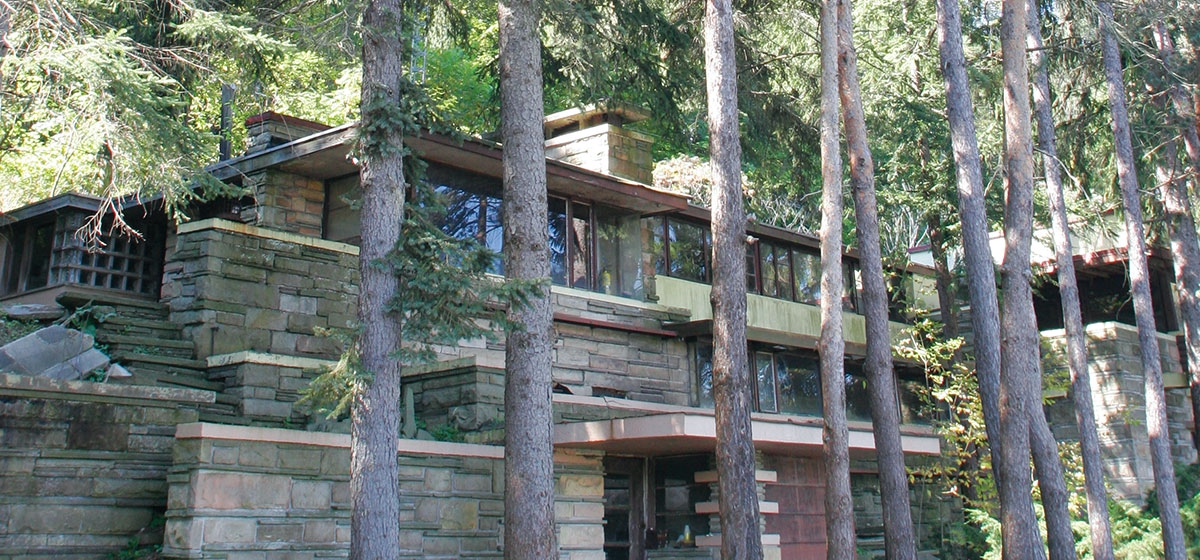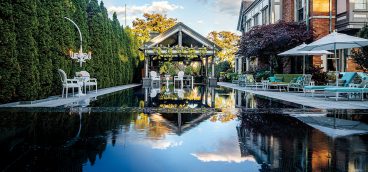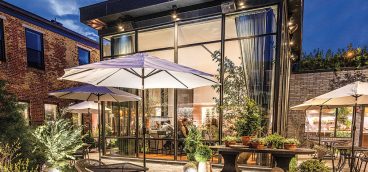Which Came First?

It is almost invisible now, a ghost of a building squatting in the shade of looming hemlocks at the edge of the highway. Though it’s now rundown and overgrown, the brooding brilliance of the place endures. You still can see its crisp, horizontal lines formed by the distinctive, rough-hewn rocks, laid by hand three-quarters of a century ago by a gifted craftsman.
[ngg src=”galleries” ids=”22″ display=”basic_thumbnail” thumbnail_crop=”0″]
It had been magnificent once, a monument to a vision of architecture as art. Those few locals who still remember it in its heyday remember the place known as Lynn Hall as an elegant and sophisticated place
But that was a long time ago. Now it seems that Lynn Hall is disappearing, retreating back into the mountainside above Port Allegany from which it had been carved. But even more important than the building itself is the mystery that continues to surround it. A remarkable achievement in its own right, the building at the top of a hill immediately brings to mind Fallingwater, the architectural icon that Frank Lloyd Wright designed at Bear Run. And there is a very real question, hotly debated by those few experts who have seen Lynn Hall: Did Fallingwater serve as a model for Lynn Hall, or did Lynn Hall, begun years earlier, provide the inspiration for at least portions of Wright’s masterpiece?
Lynn Hall has almost been forgotten, as has its builder, Walter J. Hall, a brilliant, some say eccentric, local man with a native talent for stone work and a gift for architectural improvisation.
But walk through Lynn Hall now, pushing past the detritus of years of neglect, past the discarded paint cans and old boxes, wading through rivulets of brackish water and clambering over fallen plaster, and the question of which came first echoes with every footfall
There is no question that Hall was deeply impressed with the early work of Frank Lloyd Wright, though precisely how the backwoods builder learned about the work of the revolutionary and famously flamboyant architect remains a bit of a mystery.
Perhaps, says Frank Toker, the University of Pittsburgh professor who penned “Fallingwater Rising” and has also studied Lynn Hall, Walter Hall came across some of Wright’s designs during a foray to Buffalo, N.Y., where in 1903 Wright built the Darwin-Martin house, a classic example of his prairie-style homes
It is also possible that Hall learned of Wright’s work through a former employee, Earl Friar, one of the scores of young men from the valley between Smethport and Port Allegany whom Hall put to work during his 50-plus year career. After learning his trade at Hall’s side, particularly his magical skills with stone and concrete, Friar later went to work for Wright at the Taliesin Studio in Wisconsin
Regardless of its roots, Hall’s fascination with Wright’s sense of style and design and, most importantly, his commitment to harmonizing buildings with the land bordered on the obsessive
“From the very start, when I went to work with him, he talked about Frank Lloyd Wright,” said Rudy Anderson, who 70 years ago was a young, would-be carpenter whom Hall took under his wing. “He had ideas like Frank Lloyd Wright,” the now 93-year-old Anderson recalls. “Of course at the time, it didn’t mean anything to me.”
It didn’t mean much to the comfortable burghers of Port Allegany or nearby Smethport, then two moderately prosperous oil, lumber and farming communities in McKean County for whom Hall regularly produced predictably traditional homes and fashioned appropriately subdued additions for their appropriately subdued public buildings
By all accounts, Hall’s obsession with Wright’s organic designs was generally regarded by the locals as an eccentricity, and one that his neighbors and clients might have been willing to tolerate, but would never indulge, certainly not with a contract or a commission
But that was not enough to prevent Hall from indulging his dream on his own
In the early 1930s, years before Frank Lloyd Wright sketched the first drafts for Fallingwater, Hall began work on Lynn Hall
His grandson, Ray Morton Hall, recalls a mixture of idealistic inspiration and cold, back-country pragmatism that led Hall to buy a 55-acre tract at the end of a dirt cow path and to fashion on it a kind of laboratory where, it is widely agreed, at least some of the innovations later applied to Fallingwater would be proved
The way Ray Morton Hall, known to the locals as Ray Jr., tells the story, the builder was getting on in years, and his wife had died. Though he had built houses for others and from time to time even lived in them until they were sold, he had never really built one for himself. By 1934, he found himself living in various rooming houses, taking his meals at other people’s tables
“His rationale…was that if he was going to spend the rest of his life in boarding houses and soup kitchens here and there and everywhere, then he might as well build a joint of his own,” Ray Jr. said
But it wasn’t going to be just any joint. Along with his son, Ray Hall Sr. a budding architect and sometime-builder who had a knack for losing hammers so he wouldn’t actually have to do any real physical work, Walter began sketching out the design for what he would later call a country inn. But this was to be no rustic retreat
Hall envisioned an organic building, carved out of and molded into the mountainside overlooking the pristine Allegheny River valley. To be sure, the design — long horizontal lines faced with carefully laid and hand-picked local stone capped by a sleek concrete roof and porticos — owed much of its inspiration to Wright
But the building, as Hall designed it, also reflected his understanding of what the rocky ground of Western Pennsylvania offered and what it demanded of anyone who wanted to build something that would harmonize with it
In short, as Ray Hall Jr. sees it, Lynn Hall was the first place where the vast blue of Wright’s theories came in contact with the flinty practicality of Walter Hall’s experience.
In Wright’s theoretical world, the land informs the designs. At Lynn Hall, the land itself was one of the designers of the place. The land demanded that. Back in those days, Ray Hall Jr. said, there were no earth movers readily available, no rock drills, no bulldozers. So Walter Hall and the young laborers he hired had to carve out the building site with picks, shovels and a solid appreciation of their own limitations. “That’s one of the reasons the building is up and down all over the place. You dug with a pick and shovel until you came to hard rock, and that’s where the stairs started.”
Rudy Anderson, who signed on to learn carpentry from Hall, remembered his first day on the job at Lynn Hall as something more akin to mining than woodwork. “I told him I wanted to be a carpenter, and he kind of looked me up and down and he says, ‘Why, I’ve got three or four guys like you now and three or four guys lined up behind them to tear down what they do. But come on out in the morning anyway.’ So I come out the next day. The boiler room had to be dug out 20 inches to 2 feet deeper, and that’s what he got me doing. Digging dirt. And I thought, ‘If this is carpenter work, I don’t want any part of it.’”
By 1935, according to both Anderson and Hall’s grandson, much of the work on the main structure — the dining room and ballroom, with its elaborate stone fireplaces and its sleek, carved steps leading to an elegant indoor waterfall and fish pond — had been completed, at least to the point where the vision could be clearly seen and the structure was put on the local tax rolls
That was when, at long last, Walter Hall and Frank Lloyd Wright crossed paths
Edgar Kaufmann Jr., son of the man who hired Wright to dream up his masterpiece at Bear Run, had been dispatched by his father to Buffalo to take stock of some of Wright’s earlier work. En route, he found his way to Port Allegany. While looking for a place to grab a quick meal, Kaufmann is said to have gotten into a conversation with some of the locals who told him about the eccentric builder and his odd project at the top of the hill. Kaufmann dropped in unannounced at the unfinished Lynn Hall and talked with Hall. Though he would later describe him in a conversation with author Donald Huffman as “a hillbilly builder,” at the time, Kaufmann was so struck by Hall’s work that he immediately notified his father, saying “this house is chiefly masonry, stone work and concrete — exactly the type we are to build at Bear Run.”
Shortly thereafter, the elder Kaufmann wrote to Wright. “We have our builder.”
The truth was, Wright and Kaufmann desperately needed one
The first contractor had already walked off the job, claiming that Wright’s design for Fallingwater — which often relied on specifications that were incomplete and in some cases flat wrong — could not be built. That’s when Walter Hall decided to accept the $50-a-week job Kaufmann and Wright had offered him
Hall’s decision was so swift that it took his young apprentice, Rudy Anderson, by surprise. “I was working for him about three or four weeks, and I took a weekend off and went down to see my sister in Bucks County. While I was down there, he got a call to come down and build Fallingwater,” Anderson told Pittsburgh Quarterly
“Well, his wife was dead, he was all alone and so he thought, ‘Well this is what I want to do.’ And so he left, and went right down there,” Anderson said. “Well, when I came back I was out of a job. So, two or three, or maybe a week or 10 days later, I got a call from him. He says ‘Come down, I’ve got a good job here.’”
Anderson, who did not own a car at the time, scrounged a ride down to Bear Run and when he arrived at the site, Hall had already established himself as the cock of the walk. “They had just poured the piers under Fallingwater and was pulling the forms off when we come down there,” Anderson said. “He was showing the boys how to grind the concrete with mortar and whatnot. Well he comes right back up on the bridge where I was standing, just
tickled to see me, like one of his own kids.”
Whether the famed architect recognized it or not, his design for Fallingwater left a great deal of room for improvisation. And because Wright spent long months away from the project, Hall improvised with abandon
Often it was to Wright’s chagrin, Ray Jr. said
Ray Hall Jr. noted one particularly testy letter to Wright, in which Hall informed the master designer that he had just finished pouring the support piers for the living room at Fallingwater. Hall added curtly, “I put them where I thought they ought to be on account of there’s no dimensions on your drawing.”
Hall, whose ego, by all accounts, matched Wright’s, made changes to the plans as he went along, among other things, adding reinforcement to what he saw as dangerously weak concrete, and in some cases adding flourishes to the building. In one move, apparently inspired by his Lynn Hall experience, Hall decided to leave a massive boulder in place in the living room. “You recall that big stone next to the fireplace?” Hall’s grandson asked. “That was my grandfather’s idea. Wright wanted it removed, and Walter said, ‘Why take it out? It’s natural.’”
As the work progressed on Fallingwater, the clash of egos between Wright and the builder became more dramatic. “Wright was not really a builder. He was a designer, and he was also just about as obstinate as my grandfather,” Ray Hall Jr. said.” The problem was there was only room for one god on a project, and they had two.” On at least one occasion, Walter Hall allowed himself to be photographed wrapped in an Indian blanket, Ray Hall Jr. said, a tweak at Wright’s penchant for wearing capes at the work site
For his part, Wright made no secret of his irritation with what he perceived to be Hall’s cheekiness
“I guess I took too much for granted when I called you on to the Kaufmann house. Probably, you have always been your own boss, never worked for an architect and never heard of ethics,” Wright wrote Hall in one letter that Ray Hall Jr. has kept as a treasured memento. “If you imagine your meddlesome attitude to be either sensible or honest — we will not say ethical — something was left out of either your character or your education. I have put too much into this house, even money, which item you will understand, to have it miscarry by mischievous interferences of any sort. The kind of buildings I build don’t happen that way. Several have been ruined that way however and this one may be one of them. It is only fair to say to you directly that you will either fish or cut bait or I will. I am willing to quit if I must but unwilling to go with my eyes open into the failure of my work.”
The work, of course, was not a failure. The moment it was completed, Fallingwater was celebrated as one of the world’s great architectural achievements, and Wright basked in the glory
There is no question that his design was both revolutionary and spectacular, but though the historical record is unclear, there are elements of the building for which Walter J. Hall deserves great credit, and for which Lynn Hall may well have been the model. The use of radiant heat, which was regarded as progressive when used at Fallingwater, “is probably something Wright picked up from Walter J. Hall,” says Toker. And Hall, who had used a 40-foot reinforced concrete beam that provided the spine for Lynn Hall, appears to have drawn on that experience in his construction at Fallingwater
There will always be a question about the extent of Hall’s influence over Fallingwater and to what degree Lynn Hall served as a model for it.
As Toker put it; “That Walter J. Hall was influenced by Wright is 100 percent clear, but he certainly did make contributions to Fallingwater. And maybe the
characteristic stone of Fallingwater, which Wright had not exactly used in that
matter, might be a contribution of Walter J. Hall.”
There is little question that Wright, despite his petulant outbursts, recognized that Hall had contributed a great deal to Fallingwater. Ray Hall Jr. says Wright appreciated those contributions enough to offer Hall a job at Taliesin
But by the time Fallingwater was completed, the builder had enough of Wright. He turned him down
He returned to Port Allegany, and while he continued to build other homes in the style that he honed at both Lynn Hall and Fallingwater, he never really fulfilled his dream of completing Lynn Hall
The old cow path that led to the place became part of Route 6, a scenic highway that snakes across the northern tier of the state. An apartment wing was added, and Hall and his son built a cottage — a pump house, actually, that he designed as a small home. It radiates around a central stone hearth, a building that seems to owe as much to the lessons Hall learned at Fallingwater, as Fallingwater owes to the lessons drawn from Lynn Hall.
But despite those efforts, Hall’s vision of a country inn, complete with stylish rooms fashioned out of stone and built in harmony with the land around it, never came to pass
For a time, it did operate as a restaurant, first run by the family and then by a succession of restaurateurs. It was, by all accounts, a stunningly elegant place that was advertised by a 20-foot high wooden sign posted on the hill above it that could be seen for miles
Ethlyn Ford, now 88 years old, was a 17-year-old girl when she first took a job as a waitress at Lynn Hall. She remembers it as an almost magical place where scores of nattily dressed customers from as far away as Buffalo dined in the flickering glow of the massive fireplace or glided up the polished stone staircase to dance in the expansive ballroom
“It was always busy,” she recalled
But changing tastes and changing fortunes seemed to conspire against it. Gasoline rationing during World War II slowed traffic along Route 6 to a trickle, and business dried up along with it. It didn’t help that Walter J. Hall, a teetotaler, refused to secure a liquor license for the place, though he was willing to turn a blind eye when, during parties or other functions, customers brought their own libations
By the early 1950s, the restaurant was fading into memory. In 1953, Hall died. His deathbed had been placed near the front window of the little cottage overlooking Lynn Hall and the valley below
In the years that followed, Hall’s son, Ray Sr., tried to keep Lynn Hall alive, turning it into an office of sorts for his architectural business, but after his death, Ray Jr. says the building slipped into decline
The decline accelerated when Ray Sr.’s second wife won the rights to the place, and, after living there for a time, virtually abandoned it
Ray Jr., a retired pilot, and his wife, Rhonda, an educational consultant, eventually regained control of Lynn Hall, but by that time the building needed far more work than they could afford. Recently, they’ve begun the arduous task of trying to document the building’s history and its influence on one of the world’s great architectural masterpieces
They are trying to have the place listed on the National Historic Register and are hoping that someone with a deep appreciation of the native beauty and historic significance of the building will buy it and restore it to its former glory
“That’s what we’re hoping for,” says Ray Jr., as he makes his way in the shadows up the central stairway of the old inn, past the long-dry waterfall and the dusty basin of the fish pond and into the long-abandoned ballroom
Hall understands that finding a rescuer for Lynn Hall is a long shot. But unless that happens, and unless it happens soon, the old place will continue to deteriorate and may be lost forever. That would be a tragedy.





